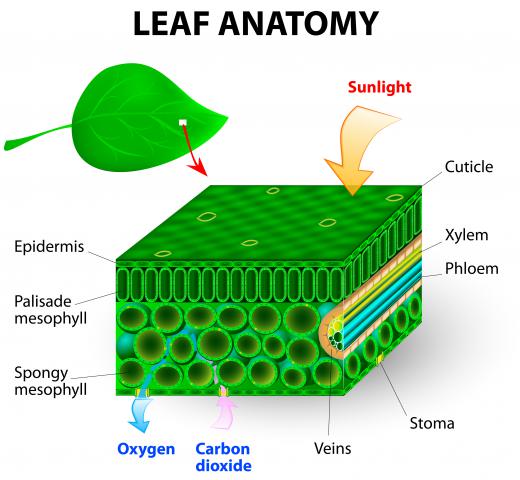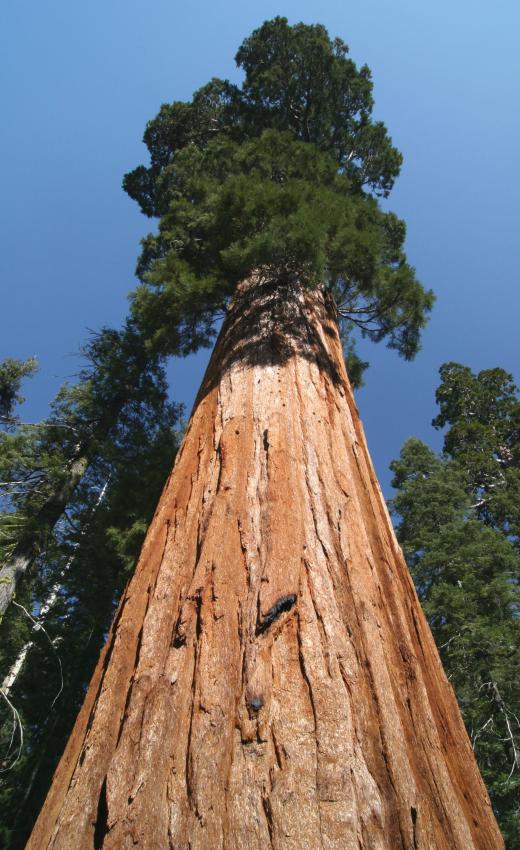In Plants, what is a Vascular System?
 Michael Anissimov
Michael Anissimov
The plant's vascular system, filled with pipe-like vascular tissue, are the crucial conduits through which water and nutrients flow in plants. Without them, plants are limited to being a few inches (centimeters) tall, as is the case with mosses, hornworts, and liverworts, the only terrestrial non-vascular plants. Most terrestrial plants alive today have a vascular system, from small shrubs to the tallest trees. The largest transport water and nutrients to the tops of trees over 379 feet (115 m) tall, such as the Giant Sequoia.
The vascular system in plants uses more than one cell type. The tissues are divided into two parts: xylem and phloem. Xylem is located more closely to the center of the plant and its main function is to transport water. The best known xylem is wood. It is mostly composed of dead cells with a tube-like structure. The phloem, however, consists mostly of living cells. Located closer to the outside of the plant, and just under the bark in trees, the phloem moves organic nutrients (known as photosynthate) to the upper reaches of the plant. The dependence of the plant upon phloem is why trees can be killed simply be removing a circular layer of bark around their circumference.

In plants, this system is found in coordinated blocks called vascular bundles, which contain xylem, phloem, and protective cells around their perimeter. As mentioned, xylem is located closer to the center, while phloem is closer to the edge. In leaves, the xylem is located on top, the phloem underneath. This is why aphids are often found on the underside of leaves: this is where they can penetrate to get sucrose from the plant's juices.

Between xylem and phloem is a layer known as the vascular cambium. It segregates the xylem and phloem from each other and is the source of the stem cells that will differentiate into both. The growth rate of cells from the vascular cambium depends on available sunlight and nutrients, and the rings found in tree trunks are indicative of the growth patterns from the vascular cambium.
AS FEATURED ON:
AS FEATURED ON:













Discussion Comments
What is the difference between ferns and fern allies? What is the role of the vascular system in fern allies and clubmoss plants?
Vascular plants create their own food and to do this they need photosynthesis which includes light, water, and carbon dioxide. Plants such as flowers are not vascular plants because they do not make their own food. The xylem in a plant is what goes up into the leaves and has minerals, nutrients, and water for the leaves of the plant. The phloem is what comes from the leaves into the roots and takes away waste and gives sap and sugars to the roots.
A bunch of phloem tubes and xylem tubes put together are called a vascular bundles. This is called the vascular system. Plant leaves are classified by palmate veins, pinnate veins, and parallel veins. They can also be determined by their leaf margins. There is one other thing in a leaf, it is called glucose. Glucose is like a backbone in a leaf.
One of the first things I learned in biology, and maybe one of the few things I remember, is the vascular system in plants. I also remember the vascular cambium and the way that pulling off bark from a tree, while lots of children do it when they're little and bored, is never a good idea.
While plants don't "breathe", exactly, it makes sense that their water vascular system is called something so similar to the system in animals.
Post your comments